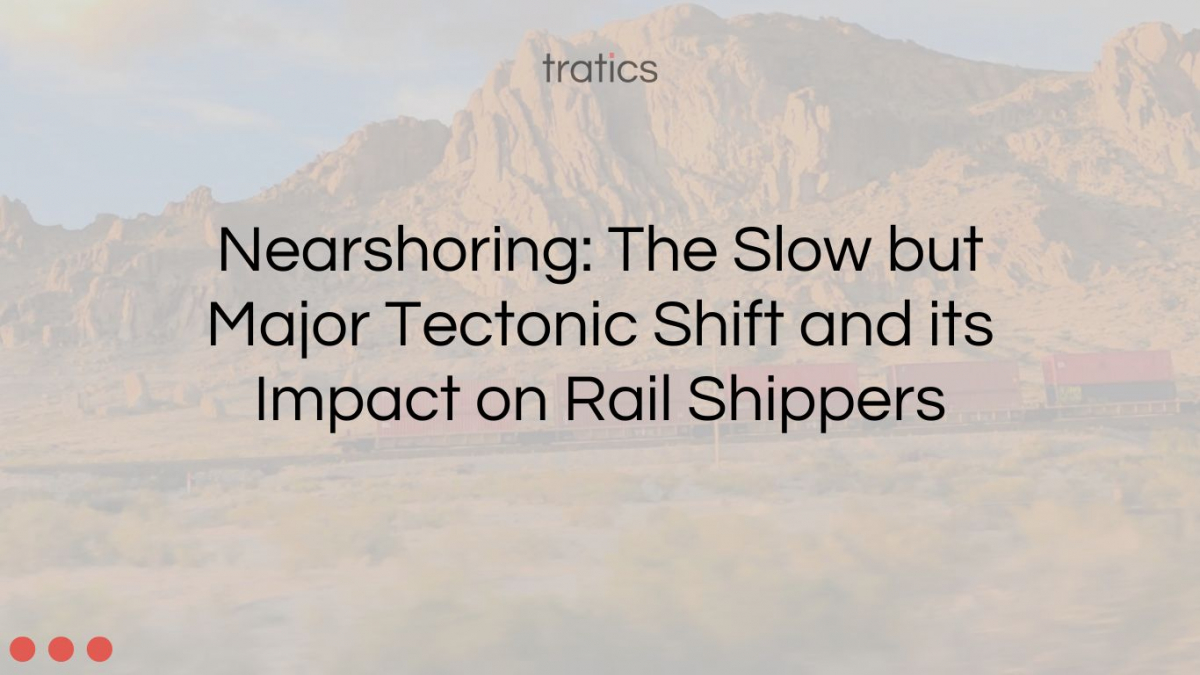As a leader of a rail logistics software company and a veteran of the rail logistics industry, I often try to take the time to look at broader trends and forces that will be shaping the freight industry landscape. One of these pivotal forces, currently shaping the future of North American supply chains, is the rapid trend of nearshoring. With an increasing number of businesses relocating their manufacturing operations closer to home, the ripple effects on rail shippers and the broader transportation sector are significant. Here, I explore these impacts and the opportunities they present, with a focus on rail shippers and the rail industry.
Rail Shippers
In the evolving logistics landscape reshaped by nearshoring, industries that ship products by rail will be able to benefit tremendously from this trend. As companies move production closer to home, they will require reliable and cost-effective means of transporting goods. Rail, with its inherent advantages in terms of capacity, fuel efficiency, and cost-effectiveness for long-haul transportation, stands to gain. As such, rail shipper companies will find themselves at the nexus of increasing opportunities, requiring both strategic foresight and efficient operations to navigate the new world.
A key element driving the demand for rail services is the industry’s ability to handle large volumes of goods over long distances at a relatively lower cost. As the length of haul increases for land transportation mode options, railroads will become the primary choice for many shippers. Increasing truck costs, paired with capacity constraints and border delay issues, add to the attractiveness of rail. Projects like the proposed rail link across Mexico's Isthmus of Tehuantepec demonstrate the massive potential for growth in rail-based logistics.
The Business Growth Opportunity
Nearshoring provides a golden opportunity for many businesses, especially industrial companies that often use rail for transporting their inputs and finished products. As manufacturing operations draw closer to the markets they serve, the need for efficient and reliable transportation of goods across Mexico, the US, and Canada will become even more critical.
The benefits to rail shippers extend beyond the immediate economic gains. By being integral to the nearshoring revolution, rail shippers can also strategically position themselves as key players in their industries. With their role more pronounced, rail shippers can use this as a lever to build stronger and more resilient businesses that can continue to grow.
Potential Rail Service Issues
This growth in rail freight demand could strain rail capacity and service quality if not managed appropriately. Declining rail service levels of recent years as the railroads raced to implement versions of PSR should serve as a reminder to shippers that while rail access may give them a competitive advantage, it can also quickly become a burden. Rail shippers will need to be watchful of service reliability and need to continue stressing the importance of investment in infrastructure to their railroad partners and industry regulators.
Railroads
Railroads stand to benefit from the nearshoring trend. Railroads will increase their freight volumes through major growth in cross-border traffic. And the railroads have seen this coming for a while now. There are no better illustrations of this than the recent CP-KCS merger, the fight between CP and CN for the takeover of KCS, and the ensuing intermodal partnership between CN-UP-FXE. We now have the first rail network spanning from Canada, through the United States, to Mexico. The merger puts CP-KCS in a strategic position to capture a large slice of the nearshoring pie. But the other railroads are not sitting still and just watching CP eat the entire pie.
However, it's not just about volume – nearshoring also creates opportunities for value-added services. Rail shippers who offer superior solutions in terms of service, speed, comprehensive supply chain visibility, and streamlined customs clearance, can gain a competitive edge in the evolving nearshoring landscape.
Carload vs. Intermodal
Intermodal business is expected to be the key driver of volume growth for the railroads as nearshoring trends continue. The increase in finished goods produced by newly nearshored operations will need efficient, cost-effective transportation to the market, often spanning large distances. This is where intermodal can shine, given its capacity for high-volume, long-haul, truck-competitive transportation. CN-UP-FEX's recent intermodal partnership underlines this point. By leveraging Union Pacific's strong network in the U.S. and Ferromex's extensive reach in Mexico, CN expects to better compete with CPKC and enhance its market share in the intermodal business.
However, this is not to say that the carload business will be sidelined. The demand for moving raw materials to factories via rail will surge. Growth trends in agriculture from population growth will continue to push the merchandise business growth forward.
Trucking
While rail will play a crucial role in nearshoring, it's not the only mode of transportation affected. Trucking stands to gain as well. As manufacturers move production closer to the US, there will be increased demand for short-haul transportation to move goods from factories or customers to rail intermodal hubs. However, it's essential to note that nearshoring will accentuate current challenges facing the trucking industry, including driver shortages and capacity constraints.
Nearshoring will shift the logistics landscape.
Nearshoring will lead to a decrease in the transoceanic freight volumes as a percentage of total freight shipments. Regional North American transportation, such as rail shipments between the US and Mexican will see a boost. The transformation of ports like Salina Cruz and Coatzacoalcos into major container and import/export facilities shows this potential. The nearshoring trend represents a transformative force in the global supply chain landscape, reshaping North American economies. For industries that are rail shippers and the rail industry itself, this shift presents both significant opportunities and notable challenges. By proactively adapting to these changes, rail shippers and railroads can take advantage of the slow but certain tectonic shift that is nearshoring.


